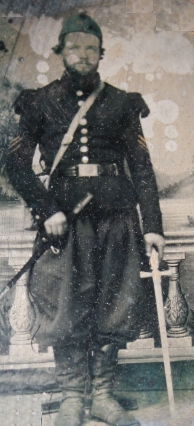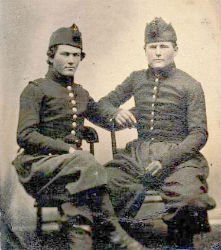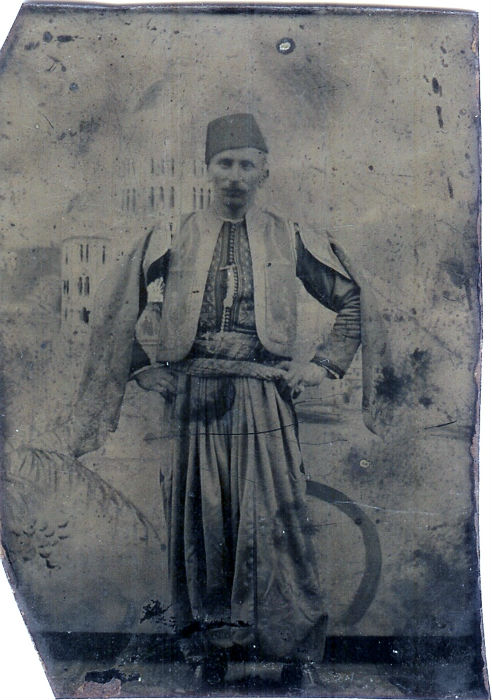62d Pennsylvania Volunteers
an American Civil War Infantry Regiment
Regimental History and
Company Rosters, Corrected and Enhanced

62d Pennsylvania Volunteersan American Civil War Infantry RegimentRegimental History and
|
|
Tales of Civil War volunteer military units typically describe how a ragtag bunch of citizens-now-soldiers are slowly molded into a crack regiment by unprepared officers who themselves have to learn discipline. Under Colonel Black, however, the volunteers of the 62d apparently excelled in drill and discipline from the beginning. Before the regiment was formed, there was a great diversity in skill and readiness among the companies. Many of the urban volunteers, however, had been members of existing Home Guard units that had been in training since the rumors of war had begun. At least one company grew out of a Zouave unit that would most likely have been funded by a generous backer for uniforms and equipment and been trained specifically as a precision military drill team. Other Home Guard units, though, may have been not have been armed with even as much as old flintlock muskets and may or may not have had uniforms. Whether or not the regiment had a headstart, "on two or three occasions," the Out-line Field History of the Sixty-second Regiment Pennsylvania Volunteers reports, "the Regiment formed a line of battle, and promptness with which the men obeyed every order, their eagerness to be well drilled caused Col. Black's heart to swell with pride and from the very first he entertained the greatest confidence in the men comprising the regiment." Even back in the Mexican War, Colonel Black had a reputation for spit and polish. According to Notes on the Mexican War, 1846-47-48, by J. Jacob Oswandel, a soldier in Black's First Pennsylvania Regiment, Black, whom Oswandel thought was "a tip-top fellow" who could be "full of jokes and fun," was a stickler for cleanliness and held dress reviews for hours under the hot sun. Even when they were under siege, Black issued orders for all of his regiment "to whiten their belts and clean their muskets, and brush themselves a little, so as to look like soldiers, and not like guerillas."
There was another reason for all the drilling. The Lincoln administration had determined at the outset of the war to recruit volunteer regiments through the states rather than expand the regular US Army. The lesson of the First Battle of Bull Run was not only that there would be no quick and easy victory by the Union forces, but that eager but inexperienced volunteers were ill-prepared for actual battle. General McClellan, commanding the Army of the Potomac, overreacted and became too cautiou. He commanded more and more drilling as he postponed engagement with the secessionist armies.
The parade ground in front of the camp was tramped "as hard as the alley ball court" according to one account. Their efforts paid off in their winning a contest held within the Army of the Potomac to select the best drilled regiments. A grand review was held at Bailey's Cross Roads at Munson's Hill, about eight miles from the capitol. Although claims at the time in letters and newspaper articles claimed that the contest included the entire Army of the Potomac, it appears to have been limited to Porter's Division of the Third Corps of the Army of the Potomac. Even if only limited to Porter's Division, the honor reflected well against the rest of the Army of the Potomac, since George McClellan may have selected Porter's Division for the contest since he had earlier called it a model division that the rest of the army should imitate because its discipline and drills were stricter than anywhere else in the army. The 62d Pennsylvania Volunteers were awarded the best of Morrell's Brigade, the 83d Pennsylvania Volunteers, commanded by Colonel John W. McLain and recruited principally in Erie County, were deemed the best of Butterfield's Brigade, and the 18th Massachusetts, led by West Pointer Colonel James Barnes, secured the uniforms out of all the regiments in Martindale's Brigade. The Out-line Field History further suggests the limits of the contest by reporting that the Colonel had as his ambition to create "the best disciplined and the most efficient in drill of any in the Brigade."
 The
winning regiments received Chasseur uniforms. According to a diary
entry from a soldier in a companion regiment, the uniforms were first
worn in a ceremony just before Christmas. Wilson, from companion
regiment 22d Massachusetts, wrote: "Dec. 21, Porter's division,
comprising fifteen thousand troops, were reviewed at Ball's
Cross-roads, and, although small as compared with that of Bailey's
Cross-roads, it was a grand spectacle. The Sixty-second and
Eighty-third Pennsylvania Volunteers appeared for the first time in
their new Chasseur uniforms, and were each presented with a stand of
colors. After the review the division was drilled, and the affair had
quite the appearance of a battle. Secretary Cameron was present, and
also Gen. McClellan."
The
winning regiments received Chasseur uniforms. According to a diary
entry from a soldier in a companion regiment, the uniforms were first
worn in a ceremony just before Christmas. Wilson, from companion
regiment 22d Massachusetts, wrote: "Dec. 21, Porter's division,
comprising fifteen thousand troops, were reviewed at Ball's
Cross-roads, and, although small as compared with that of Bailey's
Cross-roads, it was a grand spectacle. The Sixty-second and
Eighty-third Pennsylvania Volunteers appeared for the first time in
their new Chasseur uniforms, and were each presented with a stand of
colors. After the review the division was drilled, and the affair had
quite the appearance of a battle. Secretary Cameron was present, and
also Gen. McClellan."
The uniforms were constructed of very heavy material that were either purchased from French or presented by the French government. The uniforms have been incorrectly reported in some accounts as Zouave, but were "Chasseur de Vincennes." Its other designation, "French M1860 light infantry," indicates the date of its design and its origin as the French light rifleman uniform. In addition to complete uniforms, from cap and hat, to shoes and gaiters, the volunteers appear to have been awarded, among other accessories, knapsacks, haversacks, clothes brushes, and sewing kits. The winning regiments also received "camp and garrison equippage of that nation complete," including "large round French tents," pots, pans, and other mess gear. A letter written by James L. Graham, a member of Company H, describes the tents as made of linen and designed to hold 16 men, circular, 18 feet in diameter, with a center pole. In the interior, around the pole, was a rack for storing weapons.
 A
description of the uniform was provided in a newspaper article (source
unknown) included with a packet of James L. Graham's letters: "It is
blue. The breeches are about three feet across the hips, tapering down
to the ankle; a sort of blue monkey jacket, a large cape with a hood
fastened to the back of it; one tight cloth skull cap with a tassel,
and a dress parade cap which very much resembles our old patent leather
cap. This cap has a plume of red, white, and blue feathers." The
portrait of Sam Temple to the right shows well how baggy the pants
actually were. The volunteers in the double portrait to the left may be
members of the 62d P. V. or the 83d P. V. The portrait is a copy of a
tintype that surfaced in Sharon, Pa., and is presented on this website
courtesy of the Marcus S. McLemore Collection, Poland, Ohio. If the
soldiers hailed from Sharon or had family living there, it is uncertain
which regiment they might have joined. Sharon, in Mercer County, is
somewhat half way between Pittsburgh, principle home of the 62d, and
Erie, the home base of the 82d. Details from the Civil
War Veterans' Card File reveals a few 62d volunteers were from
Mercer County, but no recruiters from the 62d were sent there. For
other images of the uniform, see the portrait of William Hays of
Company E (although he had his picture taken without the cap), George Killmer
of Company L (seen in the full garment from cap on down), and Charles Seager,
Sergeant-Major of the regiment, although the portrait was probably made
when he was still serving in Company F. Ernie Spisak's article on the
62d in Gettysburg Magazine quotes an Altoona Tribune
reporter, "I am sure it is the ugliest garment on the banks of the
Potomac." None the less, many volunteers thought it a "big thing" and
hurried to be photographed in the new uniforms. The 62d was further
rewarded, perhaps more beneficially, by being re-armed so that the
entire regiment was now issued the improved Springfield rifles.
A
description of the uniform was provided in a newspaper article (source
unknown) included with a packet of James L. Graham's letters: "It is
blue. The breeches are about three feet across the hips, tapering down
to the ankle; a sort of blue monkey jacket, a large cape with a hood
fastened to the back of it; one tight cloth skull cap with a tassel,
and a dress parade cap which very much resembles our old patent leather
cap. This cap has a plume of red, white, and blue feathers." The
portrait of Sam Temple to the right shows well how baggy the pants
actually were. The volunteers in the double portrait to the left may be
members of the 62d P. V. or the 83d P. V. The portrait is a copy of a
tintype that surfaced in Sharon, Pa., and is presented on this website
courtesy of the Marcus S. McLemore Collection, Poland, Ohio. If the
soldiers hailed from Sharon or had family living there, it is uncertain
which regiment they might have joined. Sharon, in Mercer County, is
somewhat half way between Pittsburgh, principle home of the 62d, and
Erie, the home base of the 82d. Details from the Civil
War Veterans' Card File reveals a few 62d volunteers were from
Mercer County, but no recruiters from the 62d were sent there. For
other images of the uniform, see the portrait of William Hays of
Company E (although he had his picture taken without the cap), George Killmer
of Company L (seen in the full garment from cap on down), and Charles Seager,
Sergeant-Major of the regiment, although the portrait was probably made
when he was still serving in Company F. Ernie Spisak's article on the
62d in Gettysburg Magazine quotes an Altoona Tribune
reporter, "I am sure it is the ugliest garment on the banks of the
Potomac." None the less, many volunteers thought it a "big thing" and
hurried to be photographed in the new uniforms. The 62d was further
rewarded, perhaps more beneficially, by being re-armed so that the
entire regiment was now issued the improved Springfield rifles.
 The
Chasseur de Vincennes uniforms won by the 62d were never worn into
battle. According to Private Graham's letters, the regiment received
the uniforms in late 1861 and wore them in camp for a time. Colonel
Black, likely recognizing their unsuitability for active campaigning,
eventually ordered them packed up. Another problem is noted in a letter
from Col. Mclane of the 83d P.V. to General Butterfield. One third of
uniforms were too small to fit any of his volunteers and his entire
regiment could not be fitted with what remained. Black no doubt
experienced the same allotment. The uniforms were sent back to
Washington with the extra baggage in January 1862. The 62d returned to
their old sky-blue uniforms, with low shoes, leather gaiters and
leather leggings up to the knee. Ironically, some of the volunteers may
have ending up wearing parts of the uniforms later in the war. The
155th Pennsylvania, awarded the right to wear Zouave uniforms just
before the Battle of Gettysburg, were not issued genuine Zouave cut
trousers, but received the old Chasseur pants that the Quartermasters
Department pulled out of storage. Some members of the 62d joined the
155th after the 62d was mustered out, so a few of the volunteers may
have worn parts of the gaudy uniforms both at the beginning and the end
of their military careers.
The
Chasseur de Vincennes uniforms won by the 62d were never worn into
battle. According to Private Graham's letters, the regiment received
the uniforms in late 1861 and wore them in camp for a time. Colonel
Black, likely recognizing their unsuitability for active campaigning,
eventually ordered them packed up. Another problem is noted in a letter
from Col. Mclane of the 83d P.V. to General Butterfield. One third of
uniforms were too small to fit any of his volunteers and his entire
regiment could not be fitted with what remained. Black no doubt
experienced the same allotment. The uniforms were sent back to
Washington with the extra baggage in January 1862. The 62d returned to
their old sky-blue uniforms, with low shoes, leather gaiters and
leather leggings up to the knee. Ironically, some of the volunteers may
have ending up wearing parts of the uniforms later in the war. The
155th Pennsylvania, awarded the right to wear Zouave uniforms just
before the Battle of Gettysburg, were not issued genuine Zouave cut
trousers, but received the old Chasseur pants that the Quartermasters
Department pulled out of storage. Some members of the 62d joined the
155th after the 62d was mustered out, so a few of the volunteers may
have worn parts of the gaudy uniforms both at the beginning and the end
of their military careers.
For a comparison, the portrait to the right of Pvt. Lewis Workman of Company K from before the war while he was a member of the Tower Zouaves, based in Washington County, Pa., shows what a zouave uniform looked like.
The original uniforms were sky blue from top to bottom. In early
August 1861, Black requested the sky blue jackets in the style of the
uniform worn by the federal army in the Mexican war. This connection
with the Mexican War would have been in keeping with the regiment's
Scott Legion designation. The first uniforms were received within a
month. Don Troiani's Regiments and Uniforms of the Civil War
(2002) indicates that by 31 August, an initial delivery of 247 pairs of
sky blue trousers and 449 sky blue jackets were received. The fact that
a non-standard order was fulfilled so quickly likely indicates Black's
political connections. Here is a description from the Out-line Field
History:
"The Regiment here on the 3rd of September received its uniforms,
comprising a pair of sky-blue pantaloons and a neat roundabout or
jacket of the same color and material, and a dark blue cap besides a
good serviceable overcoat, shoes, underclothing etc. Companies L and M
wore a dark blue blouse which distinguished them from the others as the
flanking companies or skirmishers for the regiment." This is a strong
indication that Company L, known as the Chamber's Zouaves, did not wear
their Zouave uniforms after the company was added to the regiment. It
is likely that they received the standard jacket issue for no other
reason than those two companies were added after Black's initial
uniform request. The sky blue uniforms were worn for only about six
months. This uniform was replaced by the earned chasseur uniforms, but
by the start of the Peninsular Campaign, the volunteers donned the
standard dark blue over sky blue. According to Slim Bowser
(a member of Company D, 62nd PA Vols., a
Living Historian group), when the regiment received its designation as
the 62d Pennsylvania Volunteers shortly after it arrived on the eastern
shores of Virginia at the start of the
Peninsular campaign, the standard Union garb -- sky blue pants, dark
blue jackets -- was issued. On his site, he has a pair of tintypes
from the Ronn Palm's Museum
of Civil War Images taken of the regiment when it was still called
the Pennsylvania 33d
Independent Infantry, when the volunteers were still wearing
their light colored uniforms, both top and bottom.
As unwearable as the heavy wool chasseur uniforms may have been, even the regular issue uniforms were made of wool cloth, both blouse and trousers. Even the undergarments were of made of wool flannel. In the summers of Virginia, the uniforms must have been heat-stroke-inducing to wear. Lucky soldiers had substitute clothing sent from home, but cotton shirts and undergarments were not widely available for those in the North, since the South was then the world's main source of cotton. It may not have been a coincidence that only one major battle in which the 62d Pennsylvania was engaged was fought in the month of notoriously hot month of August.
Back to the main Pennsylvania 62d Infantry Regiment page?
This page authored and maintained by John R. Henderson (jhenderson @
icyousee . org), Lodi, NY.
Last modified: 30 April 2018, 155 years after first day of the Battle of Chancellorsville.
John R. Henderson's grandfather John G. Henderson's uncle
John Henderson
was a private in Company D.
The Sixty Second Pennsylvania Monument, pictured at the top of the
page, was dedicated at Gettysburg on 11 September 1889. The image was
printed in the book, Pennsylvania at Gettysburg, Ceremonies at the
Dedication of the Monuments, published in 1904.
URL: http://www.icyousee.org/pa62d/best.html